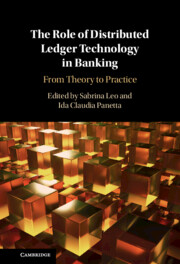Book contents
- The Role of Distributed Ledger Technology in Banking
- The Role of Distributed Ledger Technology in Banking
- Copyright page
- Dedication
- Contents
- Figures
- Tables
- Boxes
- Contributors
- Acknowledgements
- Introduction
- Part I Why Pay Attention to Distributed Ledger Technology in Banking?
- 1 Blockchain and Distributed Ledger Technologies
- 2 The Integration of Distributed Ledger Technology in Banking
- Part II Opportunities and Challenges in Crypto-Asset Regulation
- Part III The Power of Distributed Ledgers in Payments
- Part IV Enabling Financial Inclusion and ESG with Distributed Ledger Technology
- Part V A Further Look at DLT in Banking: Lessons Learned, Current Applications, and Future Scenarios
- Index
- References
1 - Blockchain and Distributed Ledger Technologies
from Part I - Why Pay Attention to Distributed Ledger Technology in Banking?
Published online by Cambridge University Press: 26 October 2023
- The Role of Distributed Ledger Technology in Banking
- The Role of Distributed Ledger Technology in Banking
- Copyright page
- Dedication
- Contents
- Figures
- Tables
- Boxes
- Contributors
- Acknowledgements
- Introduction
- Part I Why Pay Attention to Distributed Ledger Technology in Banking?
- 1 Blockchain and Distributed Ledger Technologies
- 2 The Integration of Distributed Ledger Technology in Banking
- Part II Opportunities and Challenges in Crypto-Asset Regulation
- Part III The Power of Distributed Ledgers in Payments
- Part IV Enabling Financial Inclusion and ESG with Distributed Ledger Technology
- Part V A Further Look at DLT in Banking: Lessons Learned, Current Applications, and Future Scenarios
- Index
- References
Summary
Distributed ledger technologies (DLTs) have attracted significant attention in the last few years. They gained a noticeable momentum, particularly after the introduction of blockchains as a basic building block for the development of new cryptocurrencies and tokens. This opportunity opened up new research directions to support the modern economy with numerous possibilities to redesign and innovate the market in accordance with the digital revolution we are witnessing. However, these technologies are yet to prove in practice their capability to match all the dependability and security requirements imposed in the economic and banking sector. In this chapter, we will provide an overview of the technical features of DLTs (and of blockchains in particular), outlining their potential impact in the economic field. We will first introduce the reader to their definition from a technical point of view, illustrate its core mechanisms and the guarantees they provide, and describe how these features are realised in a decentralised way. Finally, we will draw opportunities and challenges stemming from the adoption of this technology.
- Type
- Chapter
- Information
- The Role of Distributed Ledger Technology in BankingFrom Theory to Practice, pp. 11 - 34Publisher: Cambridge University PressPrint publication year: 2023
References
- 1
- Cited by



